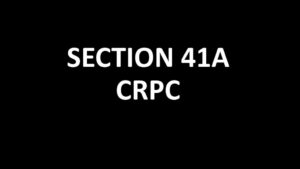Table of Contents
INTRODUCTION
SECTION 41A Crpc is a Notice of appearance before a police officer.
Section 41A CrPC provides for when can a police officer arrest a person without a warrant. It states that any police officer may without an order from a Magistrate and without a warrant, arrest any person—
(a) who commits, in the presence of a police officer, a cognizable offence;
(b) against whom a reasonable complaint has been made, or credible information has been received, or a reasonable suspicion exists that he has committed a cognizable offence punishable with imprisonment for a term which may be less than seven years or which may extend to seven years whether with or without fine, if the certain conditions are satisfied, and the police officer shall also record the reasons for such arrest.
Section 41A was added by the Code of Criminal Procedure (Amendment) Act, 2008 (5 of 2009). However, recently after the enactment of this Amendment, representations were received by the Union Government. Thus, some specific amendments were brought in by the Code of Criminal Procedure (Amendment) Act, 2010 (41 of 2010).
The earlier sub-section (1) of Section 41A read: The police officer may, in all cases where the arrest of a person is not required under the provisions of sub-section (1) of section 41, issue a notice directing the person against whom a reasonable complaint has been made, or credible information has been received, or a reasonable suspicion exists that he has committed a cognizable offence, to appear before him or at such other place as may be specified in the notice.

SECTION 41A-To confirm what the Top Court observed above, it gave the following direction:
- All the State Governments instruct their police officers not to automatically arrest when a case under Section 498-A of the I.P.C. is registered but to satisfy themselves about the necessary details before that arrest under the parameters laid down above flowing from Section 41 of Cr. P.C.;
- All police officers must be given a checklist that contains specified sub-clauses under Section 41(1)(b)(ii) of Cr.P.C.;
- The police officer should forward the checklist duly filed and produce the reasons and materials which necessitated the arrest while taking the accused before the Magistrate for his further detention;
- The Magistrate while authorizing detention of the accused shall pursue the report produced by the police officer in terms aforesaid and only after recording their satisfaction, the Magistrate will authorize detention;
- The decision not to arrest an accused must be forwarded to the Magistrate within two weeks from the date of the institution of the case with Police to the Magistrate which may be extended further by the Superintendent of Police of the district for the reasons to be recorded in writing;
- The Notice of Appearance in terms of Section 41A of Cr. P.C. must be served on the accused within two weeks from the date of institution of the case, which may further be extended by the Superintendent of Police of the District for the reasons to be recorded in writing;
- A failure to comply with the directions aforesaid shall apart from rendering the police officers concerned liable for their departmental action; shall also be held liable for contempt of court, which is to be instituted before the High Court having territorial jurisdiction.
- Authorizing detention without recording reasons as aforesaid by the judicial Magistrate concerned shall be liable for their departmental action by the High Court having territorial jurisdiction.
Finally, the Supreme Court added that the directions as mentioned earlier do not apply to the cases that fall under Section 498-A of the I.P.C. or Section 4 of the Dowry Prohibition Act, the matter in hand, but also such instances in which the offence is punishable with imprisonment for a term not less than seven years, or which may extend to seven years; either with fine or without fine.
In Arnesh Kumar’s case, the directions laid down are a statutory set of instructions to avoid unnecessary arrest. However, in this case, the safeguards deal with the incident of arrest, and the power of arrest itself is not curtailed thereby.
In the case of Amandeep Singh Johar vs State of N.C.T. of Delhi and Anr., the Delhi High Court has laid down a model format for issuance of Notice under section 41A of the Cr.P.C., containing a warning at the end of the model notice format which states that the failure to comply with the terms of this Notice, can render a person liable for arrest under Section 41A (3) and (4) of Cr. P.C.
Sub-section 3 of Section 41A contains a broader premise for arresting even though an accused appears before the investigating officer responds to the Notice of appearance. The said sub-section reads:
where such person complies and continues to comply with the notice, he shall not be arrested in respect of the offence referred to in the notice unless, for reasons to be recorded, the police officer believes that he ought to be arrested.
MUST READ
SECTION 354 OF THE INDIAN PENAL CODE
SECTION 302 OF THE INDIAN PENAL CODE
